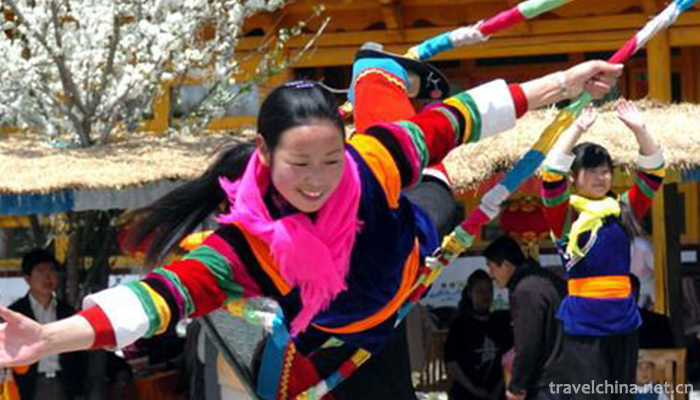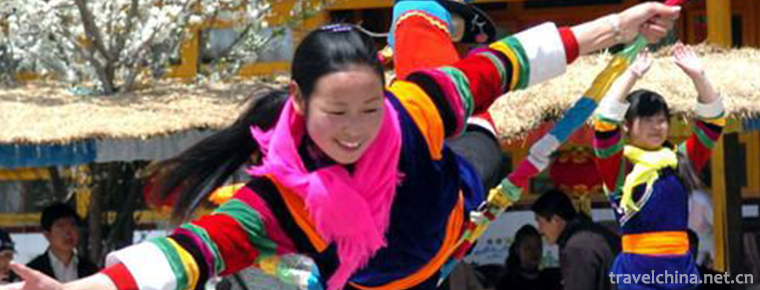Turkish Wheel Autumn
Turkish Wheel Autumn
There is a beautiful and magical legend about the origin of Tu's wheel autumn. Legend has it that in order to find a way out of life, the ancestors of the Tu nationality ploughed their fields successively with blue dragons and bison, and all of them failed. Finally, the cattle farmland was used to plough the South beach, plow the North Beach and sprinkle golden barley seeds. In autumn, wooden wagons are made to transport harvested crops. When the last cart of wheat bundles came on the stage, the car turned over and saw two belly-clearing dolls flying on the wheel of the sky, singing the harvest of the family song "Young Ge Er".
On June 7, 2008, the Tu wheels were listed in the second batch of national intangible cultural heritage list with the approval of the State Council.
historical origin
"Wheel Autumn" is a traditional entertainment of the Tus. Every year, after the busy farming in January, the Tu youths converted the boxcar into a crane with swings and turntables, and two girls in colorful clothes were flying and dancing on it. In order to be refreshing and refreshing for a year, it has become a custom for men, women and children to turn around on the wheel of autumn. Those who are skilled can also make difficult acrobatic movements.
Wheel autumn is the crystallization and symbol of the courage, wisdom and unity of the Tu people, and it is also a traditional activity that the Tu people, men, women, old and young, like to see and enthusiastically carry out.
Since then, every winter after the grinding field, people in the flat broad wheat field or spacious ground, unloading the shed of the car axles and wheels to stand up, to stabilize the center of gravity. A long wooden ladder is tied horizontally to an upward wheel. The two ends of the ladder are firmly tied to a rope loop made of epithelial or hemp ropes. They pushed the wooden ladder to rotate, then sat or stood in the rope circle with inertia, and quickly turned it, and performed various breathtaking and breathtaking action, which was applaudable. From time to time, the viewers helped push the wooden ladder to accelerate its rotation. Sometimes, a large group of young men and women in gorgeous clothes surround themselves in a circle, singing and dancing like stars and moons.
Performing methods
The wheel is made of wooden wheels of a large plate car. When moving, the axle is lifted down from the shed. The bottom fan is pressed onto the luxury block. The top fan is tied with a cross bar. The two ends of the cross bar are tied with a circle of epithelial ropes. The autumn beater sits in the rope ring and the wheel is rotated by the cross bar driven by others. In the past few years, the masses of Huzhu County improved the wheel autumn, using steel tubes as wheel discs, equipped with ball bearings, decorated with flags and ribbons, accompanied by Turkish music, together with Turkish Anzhao Dance, which became a quite distinctive national performance project.
Protection status
Turkish Wheel Autumn is listed as one of the national intangible cultural heritage lists in June 2008. In Huzhu Tu Autonomous County of Qinghai Province, women and children are well known as long as wheel autumn is mentioned. The Tu people of Mutual Aid like the traditional national sports activities of Wheel Autumn, and the performance of Wheel Autumn has won many honors for the Tu people of Mutual Aid with its strong local and national characteristics.
Folklore Situation
Tu Wheel Autumn is mainly popular in the area of Tu Autonomous County. In the past, during the leisure season, especially during the Spring Festival, people often unloaded the "upper foot" (shed) of the horse-drawn cart, and erected the "lower foot" (wheels and axles) as a whole, pressed stones and other heavy objects on the wheels touching the ground, maintained the stability and balance of the center of gravity, and tied a ladder three or four meters long horizontally on the wheels above, with a "U" (swing) seat cover at each end of the ladder. In the competition, each two people sits on the swing set, and then rotates the wheel vigorously, wins by spinning for a long time without dizziness and blindness. It is a popular sport and entertainment for men, women and children, especially for teenagers. Later, the Turkish people continued to improve the wheel autumn. Wheels are welded from steel pipes and equipped with ball bearings, which is more scientific and more safe and convenient to use. In recent years, Lunzi Autumn has been listed as a performance or competition item in the National Peasant Games and National Games, which has renewed the vitality of the ancient sports and entertainment activities of the Turkish people.


-
1.White cut chicken
White cut chicken, also known as white cut chicken, is the most common dish in Guangdong cuisine. It is a kind of chicken dipping. Its characteristics are simple and easy to prepare, without batching
Time 2018-11-02 -
2.Taining Scenic Tourist Area
Taining Scenic Spot: World Geopark, National AAAAA Class Tourist Spot, National Key Scenic Spot, National Forest Park, National Geopark, National Key Cultural Relics Protection Unit
Time 2018-12-08 -
3.Ancient Huaihe River Cultural Ecological Scenic Area
The ancient Huaihe River cultural and ecological scenic spot is located in Qingjiangpu District, Huai'an City, Jiangsu Province. It is a national AAAA-level tourist scenic spot. The scenic spot is an
Time 2019-01-12 -
4.Jinan Paomaling Tourist Area
Shandong Paomaling Scenic Area is located in the southeast of Jinan City, south of the famous mountain in China - Mount Tai, north of the cradle of the Chinese nation
Time 2019-01-21 -
5.Eight Diagrams porridge
Bagua porridge is derived from "Chinese recipe for longevity". Its main ingredients are turtle and japonica rice. It is made by boiling with other auxiliary ingredients. It can play a health
Time 2019-03-27 -
6.Legend of Anima Qingxueshan
The Legend of Anima Qing Snow Mountain refers to the legendary Anima Qing Mountain God, who is a powerful and upright God riding a high-headed white horse, holding a Mani bag (a treasure).
Time 2019-03-28 -
7.Teochew woodcarving
Chaozhou woodcarving is a Chinese folk sculpture art, mainly used for architectural decoration, artifact decoration, furniture decoration, desk decoration, etc. After careful carving
Time 2019-04-16 -
8.Green Tea Production Techniques
Green tea production technology is a national intangible cultural heritage. Luan Guapian is a special kind of green tea. Cucumber seed-like flake-shaped tea is made from local endemic varieties by wre
Time 2019-05-15 -
9.Puxian Ten Sounds and Eight Musics
Puxian Ten-tone Eight Music is not only the traditional folk art folk rap music in Putian area, but also the instrumental music. Ten tones, also known as ten times, are a comprehensive art of instrume
Time 2019-06-09 -
10.Wuqiao acrobatics
Wuqiao acrobatics is a traditional folk acrobatics art in Hebei Province. Referring to the "acrobatics town" people are often referred to as Wuqiao County, Cangzhou City, Hebei Province. Acc
Time 2019-06-29 -
11.Wudang Martial Arts
At the end of Yuan Dynasty and the beginning of Ming Dynasty, Zhang Sanfeng, a Taoist of Wudang School, established Wudang School and was respected as the founder of Wudang Wushu.
Time 2019-06-30 -
12.Jihua Temple Music
The music of Zhihua Temple and Beijing originated from the music of court etiquette in Ming Dynasty. It is the only kind of music inherited from generation to generation in China's existing ancient mu
Time 2019-08-03